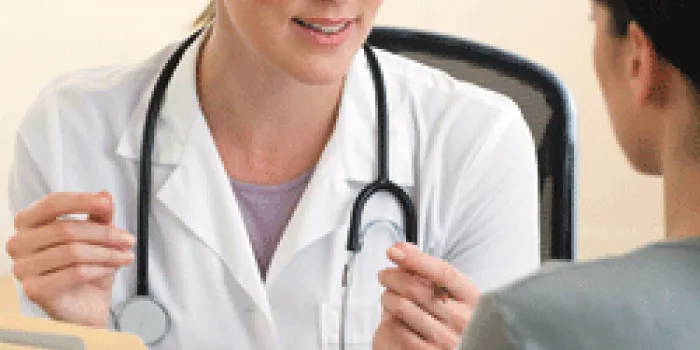After she had her first child, a daughter, 18 years ago, Lisa Collins couldn’t stand or sit for more than 10 minutes without feeling awful. That’s how severe her pain was with each menstrual cycle. Her mother had endometriosis, which occurs when cells from the lining of the uterus implant and grow outside of the uterus. Collins suspected she might have it, too.
Doctors confirmed Collins had endometriosis during laparoscopic surgery and told her she needed more surgeries to remove misplaced tissue. She hoped to avoid fertility problems, which can accompany the condition. “I was told I would never have kids again, but ‘magically,’ I had my son,” she says with a laugh. A homemaker in Columbus, Ohio, Collins has overcome her health issues and is focused on her two children. Collins, 39, learned she was a carrier after her son, now 8, was diagnosed with hemophilia A at birth.
More than five million women in the United States have endometriosis, according to the US Department of Health and Human Services (HHS). The HHS further reports that by age 50, 20% to 80% of women will develop fibroids—typically benign tumors that grow in the uterus or project outside of it.
Understanding Symptoms
Fibroids can be small or large; all are linked to estrogen. Many women with fibroids never experience signs or symptoms, and fibroids tend to shrink after menopause. But some fibroids make their presence known. They can cause pain during sex, an enlarged abdomen, bleeding between periods, or menorrhagia, heavy or painful periods.
Fibroids are named by the locations in which they grow. Some occur within the uterine wall (called intramural or myometrial) and others are in the inner cavity (called submucosal). “The fibroids that grow inside the uterine cavity are more likely to impact bleeding,” says Andrea Lukes, MD, MHSc, a gynecologist in private practice at the Carolina Women’s Research and Wellness Center in Durham. Subserosal growths project outside the uterus and can press on the bladder, causing urinary issues or occasionally backaches or constipation. Pedunculated fibroids hang from a stalk inside or outside the uterus and can cause a sharp pain if the stalk twists, although this rarely occurs.
Endometriosis can elicit pain in the back, during or following intercourse, with bowel movements and with menstrual periods. “Painful menstruation can be common for most women—they have cramps. But if it’s extremely painful or continues to get worse despite treatment, that’s another key thing that can point to endometriosis,” says Margaret Ragni, MD, MPH, professor of medicine in the Department of Medicine, Division of Hematology/Oncology at the University of Pittsburgh. She is also the director of the Hemophilia Center of Western Pennsylvania. “People who have endometriosis or fibroids could have more bleeding than those who don’t. These conditions could make your bleeding worse,” she explains.
Though the risk of developing endometriosis and fibroids can increase if a close relative has them, the causes are unclear. Statistics show that black women are more likely to have fibroids. And endometriosis is more common in women who have a history of pelvic infection, who don’t have children, or whose periods are frequent or last more than seven days. Women with bleeding disorders may be diagnosed with these conditions more often than other women, says Ragni. This may be because such women have more severe symptoms and are used to contacting their doctors more frequently, she says.
Screening and Treatment
If you experience symptoms, you can be screened and treated. Treatment varies, depending on the condition.
Fibroids can be detected through a pelvic exam or pelvic ultrasound. Most fibroids don’t require treatment. But if you are bothered by fibroids and aren’t trying to get pregnant, your healthcare provider may prescribe hormones, such as those in pill form, to reduce the severity of such symptoms as menorrhagia. Over-the-counter or prescription pain relievers can also help. Doctors may also prescribe hormones and pain medication for similar endometriosis symptoms. In severe cases, surgery may be recommended to remove fibroids or stop their blood supply.
The definitive test for endometriosis is laparoscopy, a minimally invasive surgery during which your doctor inserts a tube into the abdomen to look for endometriosis tissue. Diagnosis is made through visualization at the time of surgery or, ideally, through a biopsy, Lukes says.
Hysterectomy, removal of the uterus and sometimes the ovaries, is a treatment option for severe fibroids or endometriosis. However, it is major surgery and triggers menopause if the ovaries are removed.
If intervention is necessary, women with bleeding disorders can receive the same treatments as their peers without bleeding disorders. Surgery may be considered, but it is less likely to be the first choice because of the bleeding complications that can result.
“All options are still available, but I hope that ob/gyns work with hematologists to coordinate care,” says Lukes.
Collins had a hysterectomy in 2006 after experiencing worsening symptoms. “I feel so much better now,” she says.

